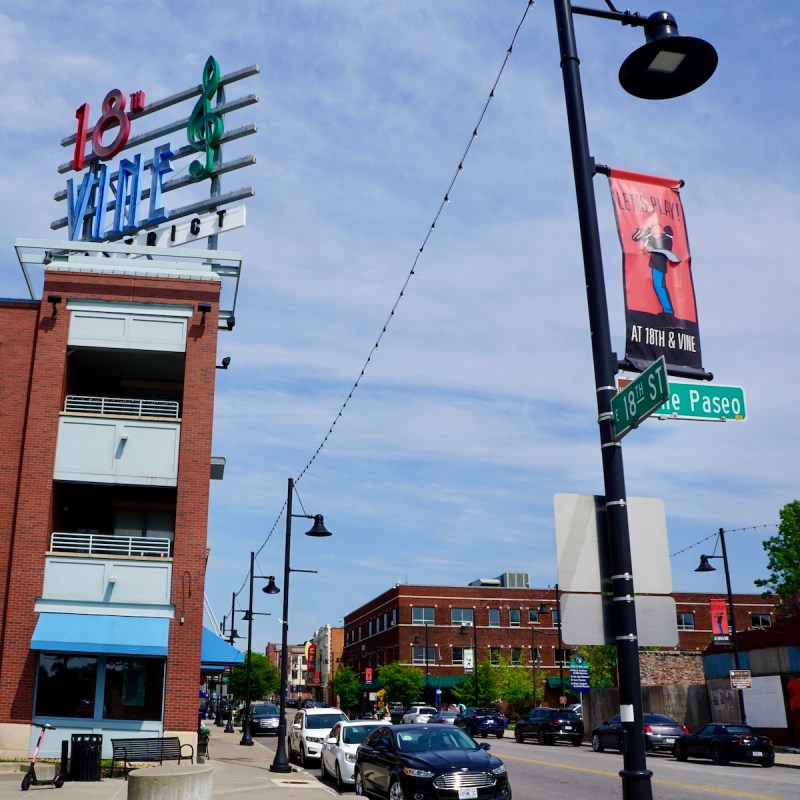
Kansas City is world renowned for a number of things — baseball, jazz, and barbeque, to name a few — and, remarkably, iconic versions of all of them can be found in one self-contained KC neighborhood known as 18th and Vine.
Videos by TravelAwaits
On my recent visit to Kansas City, Missouri, I was determined to try as many of the unique attractions as I could, and 18th and Vine was at the top of my list. Located in the center of Kansas City, the neighborhood is known as the heart of the Black business district.
I found so much to love in the neighborhood — from the history of jazz to the early baseball greats who played in the Negro Leagues to the delicious KC barbeque that got its start in a spot just off 18th Street. There were a few surprises, too, like the cool small-town feel and the lesser-known local legends.
Here are eight fascinating things to explore in Kansas City’s 18th and Vine neighborhood.

1. An 18th And Vine Stroll
One of the pleasures of a visit to Kansas City is to stroll the streets of 18th and Vine — the neighborhood that became the heart of Black business in Kansas City in the early 1900s. Today, the area continues to thrive, with its several world-renowned museums, a world-famous barbeque spot, and a vintage theater.
To me, 18th and Vine felt like its own small town within a big city, and I learned that the area has a long history of being self sufficient. The African American Heritage Trail website notes that Black Kansas Citians were prohibited by covenants and deed restrictions from moving south of 27th Street during the first half of the 20th century. That segregation served to create a self-contained business district that catered to the neighborhood.
As the community grew in population, Black doctors, dentists, and lawyers practiced and lived in the neighborhood, and more than 600 businesses flourished. Through the decades, the 18th and Vine District became the hub of Kansas City’s Black business.
On my visit, I walked from the corner of 18th Street and Paseo, which features a large free-standing 18th & Vine sign, east along 18th Street past the major museums, to Arthur Bryant’s Barbeque on Brooklyn Avenue before circling back and taking in spots like the Mutual Musicians Foundation, the Gem Theater, and the Kansas City MLB Urban Youth Academy.
Even though the neighborhood extends well beyond this walk, it offers a nice tour of some of the neighborhood’s main attractions.

2. Negro Leagues Baseball Museum
One not-to-be-missed stop along the way is the Negro Leagues Baseball Museum, an excellent museum showcasing the early baseball greats who were excluded from playing in Major League Baseball.
The museum website notes that its objective is to “highlight the obstacles that players of color faced, what they did to overcome the challenges of prejudice and social injustice in this country, and how their talent, passion and perseverance changed Major League Baseball and America.”
The museum is laid out as a timeline of the Negro Leagues and American history, and the exhibits re-create the look and feel of the early league games. Exhibits include hundreds of photos and artifacts, as well as several interactive computer stations.
I found one of the highlights to be the Field of Legends, which features 10 life-sized bronze sculptures of Negro Leagues greats. With its authentic stadium lighting and signage, the miniature field really did produce the feeling of being there, watching the action. I also enjoyed the museum’s lifestyle exhibits, such as the vintage barber shop and the photos of the fashions of the time.
Pro Tip: You could easily spend an afternoon or longer reading all of the interpretive signs and watching the videos. I recommend you set aside at least 2 hours to fully take in all that the museum has to offer.

3. American Jazz Museum
Located in the same building as the Negro Leagues Baseball Museum is the American Jazz Museum, an equally fascinating showcase of Kansas City’s place in the early days of jazz music.
As the local slogan goes, while jazz was born in New Orleans, it grew up in Kansas City. Indeed, Kansas City is known as one of the “cradles of jazz,” along with New Orleans, Chicago, and New York City.
Among the greats who got their start in Kansas City or spent significant time there were Charlie Parker, “Count” Basie, and Bennie Moten. An exhibit at the museum notes, “Kansas City was home to many legendary jazz musicians who became world renowned for their blues-based jazz style,” a museum display reads.
Jazz flourished in Kansas City in the 1930s, in part because of the city’s lax political climate that allowed alcohol to flow despite federal prohibition laws, according to the Visit KC website. “As an entertainment center, Kansas City had no equal during these dry times,” it says. That atmosphere attracted musicians from all over the country, and at one time in Kansas City, there were more than 100 nightclubs, dance halls, and vaudeville houses regularly featuring jazz music.
Kansas City’s 12th Street, along with the 18th and Vine District, served as the centers, and the city became known as “The Paris of the Plains.”
Pro Tip: Jazz has continued to flourish in Kansas City. The Visit KC website notes that more than 40 area nightclubs currently feature jazz on a regular basis.

4. The Blue Room
For a taste of authentic jazz, head to the Blue Room, the museum’s jazz club. The club was named after the famous 1930s Street Hotel club in the Historic 18th & Vine District, and it honors past jazz greats as well as showcasing present-day talents.
The Blue Room is open on select days and evenings — typically on Mondays, Thursday, Fridays, and Saturdays. It offers a full bar.
Pro Tip: Information about upcoming events and performances is available on the American Jazz Museum website.
5. Mutual Musicians Foundation
Starting in 1917, Kansas City’s African American musicians gravitated to the Local No. 627, one of a handful of African American musician unions affiliated with the American Federation of Musicians. Today, the site is known as the Mutual Musicians Foundation, and its place in history is commemorated on the African American Heritage Trail.
The club bills itself as the oldest jazz club in the world (it celebrated its 105th anniversary in April 2022), and it regularly offers performances on weekend nights. Those who want to check it out should be ready to stay up late, because the club’s hours are midnight to 6 a.m. on Fridays and Saturdays.

6. Arthur Bryant’s Barbeque
Credited with starting the Kansas City barbeque tradition, Arthur Bryant’s Barbeque has been a mainstay in the 18th and Vine District since the early 1900s. The restaurant’s website calls the restaurant’s founder the “King of Ribs,” and “the most renowned ‘barbequer’ in history.”
A visit to Arthur Bryant’s is certainly a must-do on any Kansas City itinerary. I loved the casual and friendly atmosphere, the retro décor, and, of course, the stellar barbeque. I ordered a barbeque turkey sandwich, and I was served a large stack of freshly cut and juicy turkey meat served between pieces of white bread. Smoked turkey is a favorite of mine, but if you’re a beef lover, the burnt ends also come highly recommended. Arthur Byant’s is also famous for its baby back ribs. Barbeque sauce — in various levels of sweetness and hotness — is available on the tables.
Pro Tip: Upon entering Arthur Bryant’s, you will likely have to get in line. I was lucky when I visited in the middle of the afternoon that the line was fairly short. But as I dined, I watched the line grow and the dining room fill up. From my experience, a 2–3 p.m. visit is a good strategy to avoid the crowds.
For ideas on other popular barbeque spots in Kansas City, see 7 Popular Kansas City Barbecue Restaurants And Where To Find Them.

7. The Gem Theater
A variety of community events, concerts, and theater productions take place in the grand 110-year-old Gem Theater. Originally the Star, the theater was constructed in 1912 as a silent movie palace. It was renamed the Gem in 1913.
After serving as a movie theater through the 1960s, the Gem had begun to lose its luster by the 1980s. A revitalization of the neighborhood in the 1980s included the historic Gem, and the theater became the centerpiece of the renovation efforts, according to the African American Heritage Trail website.
Pro Tip: Information on theater programming is available on the American Jazz Museum’s website.

8. Black Archives Of Mid-America
The legends of 18th and Vine extend well beyond the music, sports, and cuisine scenes. 18th and Vine is also home to the Black Archives of Mid-America, an organization with a mission to collect, preserve, and make available to the public materials documenting the social, economic, political, and cultural histories of people of African descent in the central U.S., with a particular emphasis on Kansas City. The archives offer regular exhibits that are available to the public.
I was interested to see the Kansas City Call mural along 18th Street, and after a bit of research, I learned that the long-time African American newspaper was founded in 1919 by Chester A. Franklin, a pioneer in American journalism. Franklin would go on to guide the Call for 36 years, and the newspaper continues to cover community events today. You can subscribe and download the app here.

